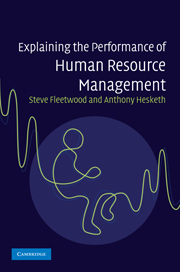Book contents
- Frontmatter
- Dedication
- Contents
- List of figures
- List of tables
- Preface
- Acknowledgements
- Part I HRM and organisational performance today
- 1 Crisis? What crisis?
- 2 Tracking the emergence of the HRM–P link paradigm
- Part II Meta-theorising the HRM–P link
- Part III Reflexive performance
- Notes
- Bibliography
- Index
2 - Tracking the emergence of the HRM–P link paradigm
Published online by Cambridge University Press: 05 July 2014
- Frontmatter
- Dedication
- Contents
- List of figures
- List of tables
- Preface
- Acknowledgements
- Part I HRM and organisational performance today
- 1 Crisis? What crisis?
- 2 Tracking the emergence of the HRM–P link paradigm
- Part II Meta-theorising the HRM–P link
- Part III Reflexive performance
- Notes
- Bibliography
- Index
Summary
[T]hose who still wait for a Newton are not only waiting for a train that won’t arrive, they’re in the wrong station altogether.
(Giddens 1975: 13)And still they wait. The information boards on the HRM–P station announce long delays, and yet those passengers advocating the measurement of the HRM–P link continue to wait on their platforms for the ‘train of science’ to arrive. The train has yet to emerge from a very long and dark tunnel in which the entrance and exit are clearly visible, but the train has somehow lost its way in the ‘black box’ in between. Meanwhile, on platforms across the station, there are additional passengers fully expecting to board the train. At one platform they are not at all concerned. They saw the train enter the blackness of the tunnel at one end, and they have observed that their platform is clearly in line with the track exiting the tunnel at the other end; and because this regularly occurs, they predict the imminent arrival of the train. Not so far away at another platform, passengers are aware of the delay but have deduced from the complexity of tracks around their platform that the train will eventually reach them – even if they are not sure how or when. On another platform they have resorted to a ‘safety in numbers’ approach and concluded that given so many passengers are waiting for trains on other platforms, they cannot all be mistaken about the train eventually arriving … can they? Word of the delay has, however, spread to other platforms where they suspect the train might never arrive and are making their feelings known to the station’s staff. Meanwhile, a small number of passengers are leaving the station and heading for their cars and bicycles. They already know the train of ‘science’ is never going to arrive.
- Type
- Chapter
- Information
- Explaining the Performance of Human Resource Management , pp. 33 - 60Publisher: Cambridge University PressPrint publication year: 2010



